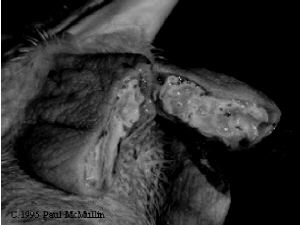ThePoultrySite Quick Disease Guide
Fowl Cholera, Pasteurellosis
|
Extracted From:
A Pocket Guide to
Poultry Health and Disease 
|
Introduction
Fowl Cholera is a serious, highly contagious disease caused by the bacterium Pasteurella multocida in a range of avian species including chickens, turkeys, and water fowl, (increasing order of susceptibility). It is seen worldwide and was one of the first infectious diseases to be recognised, by Louis Pasteur in 1880.
The disease can range from acute septicaemia to chronic and localised infections and the morbidity and mortality may be up to 100%. The route of infection is oral or nasal with transmission via nasal exudate, faeces, contaminated soil, equipment, and people. The incubation period is usually 5-8 days.
The bacterium is easily destroyed by environmental factors and disinfectants, but may persist for prolonged periods in soil. Reservoirs of infection may be present in other species such as rodents, cats, and possibly pigs.
Predisposing factors include high density and concurrent infections such as respiratory viruses.
Signs
- Dejection.
- Ruffled feathers.
- Loss of appetite.
- Diarrhoea.
- Coughing.
- Nasal, ocular and oral discharge.
- Swollen and cyanotic wattles and face.
- Sudden death.
- Swollen joints.
- Lameness.
Post-mortem lesions
- Sometimes none, or limited to haemorrhages at few sites.
- Enteritis.
- Yolk peritonitis.
- Focal hepatitis.
- Purulent pneumonia (especially turkeys).
- Cellulitis of face and wattles.
- Purulent arthritis.
- Lungs with a consolidated pink 'cooked' appearance in turkeys.
Diagnosis
Impression smears, isolation (aerobic culture on trypticase soy or blood agar yields colonies up to 3mm in 24 hours - no growth on McConkey), confirmed with biochemical tests.
Differentiate from Erysipelas, septicaemic viral and other bacterial diseases.
Treatment
Sulphonamides, tetracyclines, erythromycin, streptomycin, penicillin. The disease often recurs after medication is stopped, necessitating long-term or periodic medication.
Prevention
Biosecurity, good rodent control, hygiene, bacterins at 8 and 12 weeks, live oral vaccine at 6 weeks.
 |
| Figure 19. Severe localised Pasteurella infection in the swollen wattle of a 30-week-old male broiler parent chicken. The swelling is made up of oedema and purulent exudates (pus). |


 © 2000 - 2021. Global Ag MediaNinguna parte de este sitio puede ser reproducida sin previa autorización.
© 2000 - 2021. Global Ag MediaNinguna parte de este sitio puede ser reproducida sin previa autorización.